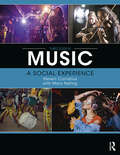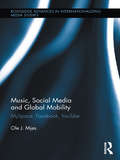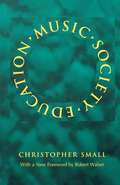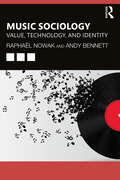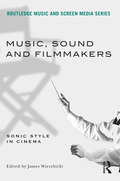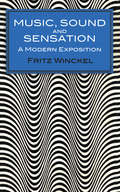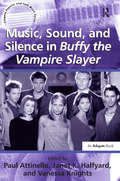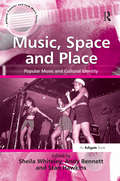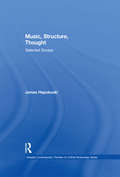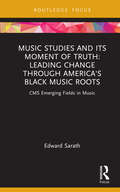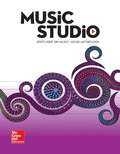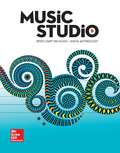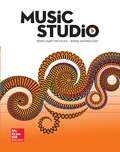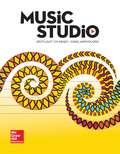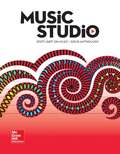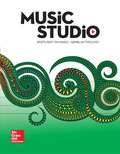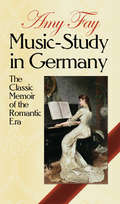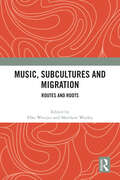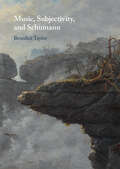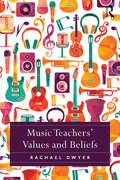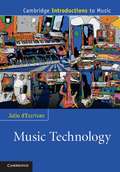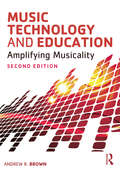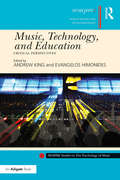- Table View
- List View
Music: A Social Experience
by Steven Cornelius Mary NatvigBy taking a thematic approach to the study of music appreciation, Music: A Social Experience, Third Edition demonstrates how music reflects and deepens both individual and cultural understandings. Musical examples are presented within universally experienced social frameworks (ethnicity, gender, spirituality, love, and more) to help students understand how music reflects and advances human experience. Students engage with multiple genres (Western art music, popular music, and world music) through lively narratives and innovative activities. A companion website features streaming audio and instructors' resources. The third edition includes: A chapter on Black American music A revised and developed chapter on gender and sexuality A dozen additional Listening Guides, with an emphasis on contemporary popular music Over 100 new full-color images Updated teacher and student resources on the book’s companion website Expanded content throughout, highlighting the social, cultural, and technological changes since publication of the previous edition The culmination of thirty years of experimentation in the music appreciation classroom, this third edition of Music: A Social Experience continues to empower lifelong musical learning by engaging students and readers on their own terms.
Music, Social Media and Global Mobility: MySpace, Facebook, YouTube (Routledge Advances in Internationalizing Media Studies)
by Ole J. MjosThis book is about the relationship between media, communication and globalization, explored through the unique empirical study of electronic music practitioners’ use of the global social media: MySpace, Facebook, YouTube and Twitter. To understand the significance of the emerging nexus between social media and music in a global context, the book explores various aspects of production, distribution and consumption among electronic music practitioners as they engage with global social media, as well as a historical, political and economic exposition of the rise of this global social media environment. Drawing on interview-based research with electronic music artists, DJs, producers and managers, together with the historical portrayal of the emergence of global social media this pioneering study aims to capture a development taking place in music culture within the wider transformations of the media and communications landscape; from analogue to digital, from national to global, and from a largely passive to more active media use. In doing so, it explores the emergence of a media and communications ecology with increased mobility, velocity and uncertainty. The numerous competing, and rapidly growing and fading social media exemplify the vitality and volatility of the transforming global media, communication and cultural landscape. This study suggests that the music practitioner’s relationship with MySpace, Facebook, YouTube and Twitter and the key characteristics of these global social media, alter aspects of our practical and theoretical understandings of the process of media globalization. The book deploys an interdisciplinary approach to media globalization that takes into account and articulates this relationship, and reflects the enduring power equations and wider continuities and changes within the global media and communications sphere.
Music, Society, Education (Music Culture)
by Christopher Small Robert WalserCited by Soundpost as "remarkable and revolutionary" upon its publication in 1977, Music, Society, Education has become a classic in the study of music as a social force. Christopher Small sets out to examine the social implications of Western classical music, effects that until recently have been largely ignored or dismissed by most musicologists. He strives to view the Western musical tradition "through the mirror of these other musics [Balinese and African] as it were from the outside, and in so doing to learn something of the inner unspoken nature of Western culture as a whole."As series co-editor Robert Walser writes, "By pointing to the complicity of Western culture with Western imperialism, Small challenges us to create a future that is more humane than the past. And by writing a book that enables us to rethink so fundamentally our involvements with music, he teaches us how we might get there."
Music Sociology: Value, Technology, and Identity
by Andy Bennett Raphaël NowakMusic Sociology critically evaluates current approaches to the study of music in sociology and presents a broad overview of how music is positioned and represented in existing sociological scholarship. It then goes on to offer a new framework for approaching the sociology of music, taking music itself as a starting point, and considering what music sociology can learn from related disciplines such as critical musicology, ethnomusicology, and cultural studies. As a central form of leisure, consumption, and cultural production, music has attracted significant attention from sociologists who seek to understand its deeper socio-cultural meaning. With case studies that address sound environments, consumption, media technologies, local scenes, music heritage, and ageing, the authors highlight the distinctive nature of musical experience, and show how sociology can illuminate it. Providing both a survey of existing perspectives the sociology of music, and a thought-provoking discussion of how the field can move forward, this concise and accessible book will be a vital reading for anyone teaching or studying music from a sociological standpoint.
Music, Sound and Filmmakers: Sonic Style in Cinema
by James WierzbickiMusic, Sound and Filmmakers: Sonic Style in Cinema is a collection of essays that examine the work of filmmakers whose concern is not just for the eye, but also for the ear. The bulk of the text focuses on the work of directors Wes Anderson, Ingmar Bergman, the Coen brothers, Peter Greenaway, Krzysztof Kieślowski, Stanley Kubrick, David Lynch, Quentin Tarantino, Andrey Tarkovsky and Gus Van Sant. Significantly, the anthology includes a discussion of films administratively controlled by such famously sound-conscious producers as David O. Selznick and Val Lewton. Written by the leading film music scholars from Europe, North America, and Australia, Music, Sound and Filmmakers: Sonic Style in Cinema will complement other volumes in Film Music coursework, or stand on its own among a body of research.
Music, Sound and Sensation: A Modern Exposition
by Fritz WinckelRelated closely to the field of physical acoustics is that of psychoacoustics, which deals with the phenomena of musical hearing from a psychological and aesthetic point of view. One of the major contributors to our understanding of the subject is Fritz Winckel. When this book first appeared in German in 1960, reviewers pressed for an English translation. This Dover volume is an answer to that demand: it makes Professor "Winckel's important study generally available to English-language readers for the very first time." It has been extensively revised and updated by the author.In his thought-provoking study, Professor Winckel applies the findings of technical researches in acoustics to the practice of music, covering many different aspects of recent psychoacoustical researches: the evaluation of loudness and the dissolution power of the car; the influence of the acoustical properties of the concert hall on the hearing process; the function of time variation and rhythm in musical perception; the evaluation of the sound spectrum including the unharmonic components. He surveys extensively the German and English literature in the field, organizing his information into chapters on stationary sound, the onset behavior of sound, the concept of space, the concept of time, the evaluation of sound through the hearing mechanism, unclarity in musical structures, simultaneously sounding tones, electroacoustic sound structure, and the effect of music on the listener.This book should prove equally useful to acousticians, sound engineers, and others working in this area of applied physics and to composers, performers, and musicologists concerned with the technical aspects of music. Psychologists working in the field of sense perception will also find much of value here.New translation by Thomas Binkley of the 1960 German edition of Phänomene des musikalischen Hörens, with revisions and corrections by the author.
Music, Sound, and Silence in Buffy the Vampire Slayer (Ashgate Popular And Folk Music Ser.)
by JanetK. HalfyardThe intense and continuing popularity of the long-running television show Buffy the Vampire Slayer (1997-2003) has long been matched by the range and depth of the academic critical response. This volume, the first devoted to the show's imaginative and widely varied use of music, sound, and silence, helps to develop an increasingly important and inadequately covered area of research - the many roles of music in contemporary television. In addressing this significant gap, this book provides an exemplary overview of the functions of music and sound in the interpretation of a television show. This is done through analyses that focus on scoring and source music, the title theme, the music production process, the critically acclaimed musical episode (voted number 13 in Channel Four's One Hundred Greatest Musicals), the symbolic and dramatic use of silence, and the popular reception of the show by its international fan base. In keeping with contemporary trends in the study of popular musics, a variety of critical approaches are taken from musicology, cultural studies, and media and communication studies, specifically employing critique, musical analysis, industry studies, and hermeneutics.
Music, Sound and Space
by Georgina BornMusic, Sound and Space is the first collection to integrate research from musicology and sound studies on music and sound as they mediate everyday life. Music and sound exert an inescapable influence on the contemporary world, from the ubiquity of MP3 players to the controversial use of sound as an instrument of torture. In this book, leading scholars explore the spatialisation of music and sound, their capacity to engender modes of publicness and privacy, their constitution of subjectivity, and the politics of sound and space. Chapters discuss music and sound in relation to distinctive genres, technologies and settings, including sound installation art, popular music recordings, offices and hospitals, and music therapy. With international examples, from the Islamic soundscape of the Kenyan coast, to religious music in Europe, to First Nation musical sociability in Canada, this book offers a new global perspective on how music and sound and their spatialising capacities transform the nature of public and private experience.
Music, Space and Place: Popular Music and Cultural Identity (Ashgate Popular And Folk Music Ser.)
by Andy BennettMusic, Space and Place examines the urban and rural spaces in which music is experienced, produced and consumed. The editors of this collection have brought together new and exciting perspectives by international researchers and scholars working in the field of popular music studies. Underpinning all of the contributions is the recognition that musical processes take place within a particular space and place, where these processes are shaped both by specific musical practices and by the pressures and dynamics of political and economic circumstances. Important discourses are explored concerning national culture and identity, as well as how identity is constructed through the exchanges that occur between displaced peoples of the world's many diasporas. Music helps to articulate a shared sense of community among these dispersed people, carving out spaces of freedom which are integral to personal and group consciousness. A specific focal point is the rap and hip hop music that has contributed towards a particular sense of identity as indigenous resistance vernaculars for otherwise socially marginalized minorities in Cuba, France, Italy, New Zealand and South Africa. New research is also presented on the authorial presence in production within the domain of the commercially driven Anglo-American music industry. The issue of authorship and creativity is tackled alongside matters relating to the production of musical texts themselves, and demonstrates the gender politics in pop. Underlying Music, Space and Place, is the question of how the disciplines informing popular music studies - sociology, musicology, cultural studies, media studies and feminism - have developed within a changing intellectual climate. The book therefore covers a wide range of subject matter in relation to space and place, including community and identity, gender, race, 'vernaculars', power, performance and production.
Music, Structure, Thought: Selected Essays (Ashgate Contemporary Thinkers On Critical Musicology Ser.)
by James HepokoskiAmong the most original and provocative musicological writers of his generation, James Hepokoski has elaborated new paradigms of inquiry for both music history and music theory. Advocating fundamental shifts of methodological reorientation within the quest for potential musical meanings, his work spans both disciplines and offers substantial challenges for each. At its core is the conviction that a close study of musical genres, procedures, and structures those qualities of a composition that are specifically musical is essential to any responsible hermeneutic enterprise. Selected from writings from 1984 to 2008, this collection of essays provides a generous introduction to the author‘s most innovative and influential work on a wide variety of topics: musicological methodology, issues of staging and performance, Italian opera, program music, and exemplary studies of individual pieces.
Music Studies and Its Moment of Truth: CMS Emerging Fields in Music (CMS Emerging Fields in Music)
by Edward SarathMusic Studies and Its Moment of Truth: Leading Change through America’s Black Music Roots presents a new framework for racial justice discourse in the context of music studies and education. Centering on Black American Music, the book issues challenges to both the conventional music studies paradigm and decades-old reform efforts. While Black American Music ranks high among America’s contributions to world culture, and offers musicians powerful tools for musical practice and understanding, this musical legacy remains remarkably marginalized even in activist conversations. The author argues that this reflects lingering and unexamined racist patterns that persist even among the most fervent voices for anti-racist interventions, and addresses the need for a higher-order activist framework within music studies. Delving further into the transformative changes needed to pursue racial justice, the short pieces collected in this book discuss topics including a shift from multicultural ideology to a transcultural model of musical pluralism, analysis of the multi-tiered nature of musical racism, the whitewashing of music studies activism, K-12 music teacher education as the locus for paradigmatic change and the potential for a transformed model of music studies to catalyze an overarching revolution in creativity and consciousness in both education and society at large. Critiquing the failures of progressive reform efforts and conventional reaction, this book argues that major changes are needed to the discourse on racism in music studies, and envisions new paradigms for the future.
Music Studies and Its Moment of Truth: CMS Emerging Fields in Music (CMS Emerging Fields in Music)
by Edward SarathMusic Studies and Its Moment of Truth: Leading Change through America’s Black Music Roots presents a new framework for racial justice discourse in the context of music studies and education. Centering on Black American Music, the book issues challenges to both the conventional music studies paradigm and decades-old reform efforts.While Black American Music ranks high among America’s contributions to world culture, and offers musicians powerful tools for musical practice and understanding, this musical legacy remains remarkably marginalized even in activist conversations. The author argues that this reflects lingering and unexamined racist patterns that persist even among the most fervent voices for anti-racist interventions, and addresses the need for a higher-order activist framework within music studies.Delving further into the transformative changes needed to pursue racial justice, the short pieces collected in this book discuss topics including a shift from multicultural ideology to a transcultural model of musical pluralism, analysis of the multi-tiered nature of musical racism, the whitewashing of music studies activism, K-12 music teacher education as the locus for paradigmatic change and the potential for a transformed model of music studies to catalyze an overarching revolution in creativity and consciousness in both education and society at large. Critiquing the failures of progressive reform efforts and conventional reaction, this book argues that major changes are needed to the discourse on racism in music studies, and envisions new paradigms for the future.
Music Studio: Spotlight On Music [Grade 5], Song Anthology (General Music Ser.)
by Judy Bond René Boyer Margaret Campbelle-HolmanNIMAC-sourced textbook
Music Studio: Spotlight On Music [Grade 2], Song Anthology (General Music Ser.)
by Judy Bond René Boyer Margaret Campbelle-HolmanNIMAC-sourced textbook
Music Studio: Spotlight On Music [Grade 3], Song Anthology (General Music Ser.)
by Judy Bond René Boyer Margaret Campbelle-HolmanNIMAC-sourced textbook
Music Studio: Spotlight On Music [Grade K], Song Anthology (General Music Ser.)
by Judy Bond René Boyer Margaret Campbelle-HolmanNIMAC-sourced textbook
Music Studio: Spotlight on Music [Grade 1], Song Anthology (General Music Ser.)
by Judy Bond René Boyer Margaret Campbelle-HolmanNIMAC-sourced textbook
Music Studio: Spotlight on Music [Grade 4], Song Anthology (General Music Ser.)
by Judy Bond René Boyer Margaret Campbelle-HolmanNIMAC-sourced textbook
Music-Study in Germany: The Classic Memoir of the Romantic Era (Dover Books On Music: History)
by Amy Fay Frances DillonIn this series of letters written between November 1869 and May 1875, a young American pianist, Amy Fay, recounts the thrilling experience of studying piano with such great teachers as Liszt, Tausig, and Kullak. Printed 21 times in America, published also in London, and translated into French and German, this book has clearly established its wide appeal to music students.The author describes the customs and mores, the place of interest, and the people she encountered during her stay in Germany, then the music capital of the world. In a vivid style and with youthful exuberance, she imparts to the reader her impressions of performances by Anton Rubinstein, Clara Schumann, Tausig, Liszt, the great violinist Joachim, Wagner (as conductor), and other notables of music history. Her account of a reception and concert in honor of Wagner is especially fascinating.But the sections of this entirely engaging work that are of primary importance to music students, particularly to students and teachers of the piano, are the author's detailed accounts of the teaching methods of the great piano virtuosi. Interesting pictures of lessons of Tausig's conservatory, of Kullak's teaching techniques, and, above all, a unique portrait of Liszt the man, the teacher, and the performer emerge from these letters. So valued are Amy Fay's impressions of Liszt, in fact, that these sections alone are regarded as a miniature classic. For this Dover edition, Professor Frances Dillon of the Mannes College of Music contributed an informative introduction.Because of her position as a student working closely with Liszt, Tausig, Kullak, and Deppe, Amy Fay was able to reveal many little-known facets of their work and their teaching techniques. Her obvious enthusiasm and serious attitude towards her study make this a work of great liveliness and rare insight. Not only students of the piano, but all musicologists will find her comments and descriptions invaluable. And the general reader should enjoy the many anecdotes and personal glimpses of these famous names in music.
Music, Subcultures and Migration: Routes and Roots
by Elke Weesjes Matthew WorleyThis edited volume concentrates on the period from the 1940s to the present, exploring how popular music forms such as blues, disco, reggae, hip hop, grime, metal and punk evolved and transformed as they traversed time and space. Within this framework, the collection traces how music and subcultures travel through, to and from democracies, autocracies and anocracies.The chosen approach is multidisciplinary and deliberately diverse. Using both archival sources and oral testimony from a wide variety of musicians, promoters, critics and members of the audience, contributors from a range of academic disciplines explore music and subcultural forms in countries across Asia, Europe, Oceania, North America and Africa. They investigate how far the meaning of music and associated subcultures change as they move from one context to another and consider whether they transcend or blur parameters of class, race, gender and sexuality.
Music, Subjectivity, and Schumann Music, Subjectivity, and Schumann
by Benedict TaylorThe concept of subjectivity is one of the most popular in recent scholarly accounts of music; it is also one of the obscurest and most ill-defined. Multifaceted and hard to pin down, subjectivity nevertheless serves an important, if not indispensable purpose, underpinning various assertions made about music and its effect on us. We may not be exactly sure what subjectivity is, but much of the reception of Western music over the last two centuries is premised upon it. Music, Subjectivity, and Schumann offers a critical examination of the notion of musical subjectivity and the first extended account of its applicability to one of the composers with whom it is most closely associated. Adopting a fluid and multivalent approach to a topic situated at the intersection of musicology, philosophy, literature, and cultural history, it seeks to provide a critical refinement of this idea and to elucidate both its importance and limits.
Music Teachers' Values and Beliefs
by Rachael DwyerIn Music Teachers' Values and Beliefs, Dwyer investigates the relationships between teachers, learners and music in music classrooms. Using Bourdieu's concepts of habitus and doxa as an interpretive lens, the book explores the values and beliefs of four music teachers, depicted in richly detailed narratives. The narratives are contextualised through the examination of traditions of music and contemporary approaches. In the past, music education has been shaped by elitist tendencies regarding the types of music worthy of study, the ways in which music should be learnt, and the purpose of such learning. Contemporary approaches to music education have enacted significant change in some regions and systems, while others have been slower to leave behind deeply entrenched values, beliefs and practices. These approaches have been blamed for low rates of participation and engagement in school music education, despite the fact that the majority of young people listen to and enjoy music outside of school. This innovative book provides music education researchers and practitioners with a new understanding of the impact of teachers' personal values, beliefs and experiences of music and music education on classroom practice, and the impact this has on students' experiences of music education.
Music Technology
by Julio D'EscrivánEmphasising the creative aspect of music technology, this introduction sets out an overview of the field for music students in a non-scientific and straightforward way. Engaging and user-friendly, the book covers studio concepts: basic audio and the studio workflow, including audio and MIDI recording. It explores synthesisers, samplers and drum machines as well as basic concepts for electronic performance. In considering the role of the DJ, the book addresses remixing and production, drawing upon many examples from the popular music repertoire as well as looking at the studio as an experimental laboratory. The creative workflow involved in music for media is discussed, as well as controllers for performance and the basics of hacking electronics for music. The book as a whole reflects the many exciting areas found today in music technology and aims to set aspiring musicians off on a journey of discovery in electronic music.
Music Technology and Education: Amplifying Musicality
by Andrew BrownMusic Technology in Education lays out the principles of music technology and how they can be used to enhance musical teaching and learning in primary and secondary education. Previously published as Computers in Music Education, this second edition has been streamlined to focus on the needs of today’s music education student. It has been completely updated to reflect mobile technologies, social networks, rich media environments, and other technological advances. Topics include: Basic audio concepts and recording techniques Enhanced music instruction with interactive systems, web-based media platforms, social networking, and musicianship software Administration and management of technology resources Distance education and flexible learning Music Technology in Education provides a strong theoretical and philosophical framework for examining the use of technology in music education while outlining the tools and techniques for implementation in the classroom. Reflective Questions, Teaching Tips, and Suggested Tasks link technology with effective teaching practice. The companion website provides resources for deeper investigation into the topics covered in each chapter, and includes an annotated bibliography, website links, tutorials, and model projects.
Music, Technology, and Education: Critical Perspectives (SEMPRE Studies in The Psychology of Music)
by Andrew King Evangelos HimonidesThe use of technology in music and education can no longer be described as a recent development. Music learners actively engage with technology in their music making, regardless of the opportunities afforded to them in formal settings. This volume draws together critical perspectives in three overarching areas in which technology is used to support music education: music production; game technology; musical creation, experience and understanding. The fourteen chapters reflect the emerging field of the study of technology in music from a pedagogical perspective. Contributions come not only from music pedagogues but also from musicologists, composers and performers working at the forefront of the domain. The authors examine pedagogical practice in the recording studio, how game technology relates to musical creation and expression, the use of technology to create and assess musical compositions, and how technology can foster learning within the field of Special Educational Needs (SEN). In addition, the use of technology in musical performance is examined, with a particular focus on the current trends and the ways it might be reshaped for use within performance practice. This book will be of value to educators, practitioners, musicologists, composers and performers, as well as to scholars with an interest in the critical study of how technology is used effectively in music and music education.
